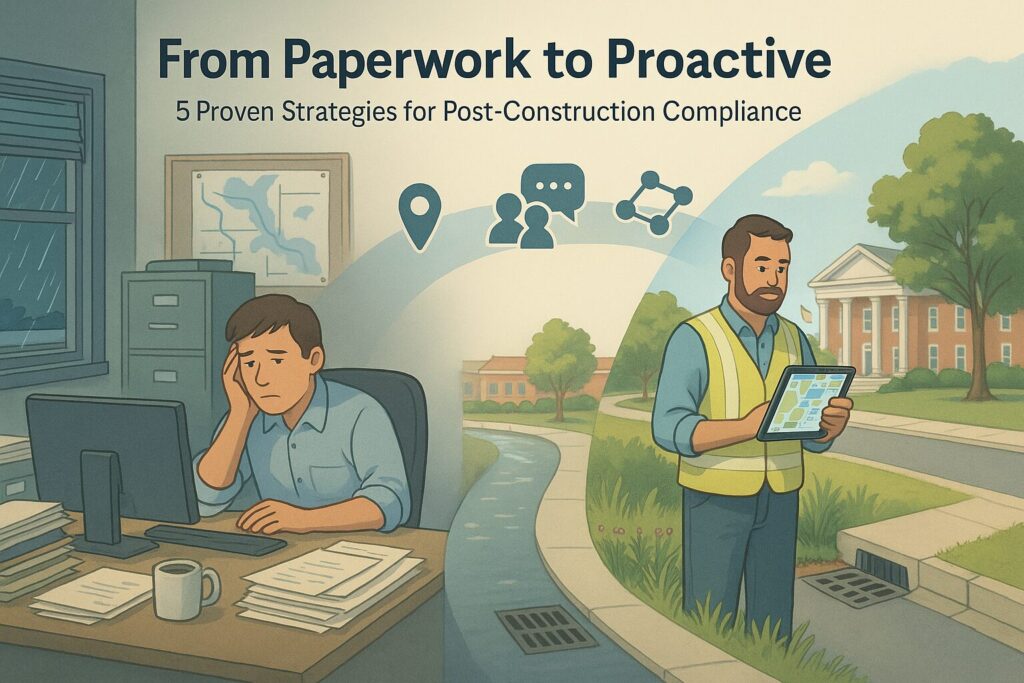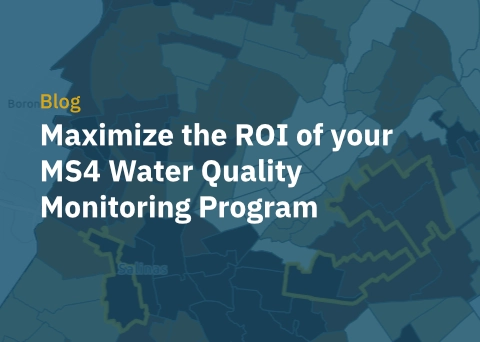For municipalities managing MS4 stormwater programs, post-construction compliance often represents one of the most challenging aspects of permit requirements. With limited staff, tight budgets, and aging infrastructure, many stormwater teams find themselves stuck in reactive mode—buried in paperwork and struggling to track private stormwater assets effectively.
But there’s a better way forward that doesn’t require a massive investment. By implementing strategic digital approaches, your stormwater program can transition from merely responding to compliance issues to proactively managing them. This will also deliver measurable ROI through time savings and enhanced flood resilience in your community.
By implementing a comprehensive digital solution like the 2NFORM Post-Construction Module, municipalities have reported up to 50% reduction in compliance management time.

The Post-Construction Challenge
Post-construction stormwater management presents unique challenges that distinguish it from other MS4 program areas:
- Long-term maintenance requirements: Once development projects complete construction and building permits close, the responsibility for maintaining stormwater assets shifts to private landowners—while MS4 teams remain accountable for enforcement.
- Limited visibility into private properties: Without easy ways to track maintenance activities, municipalities often rely on resource-intensive annual reports or field inspections.
- Paperwork bottlenecks: Compliance processes still heavily depend on manual forms, PDFs, and spreadsheets that consume valuable staff time.
- Institutional knowledge risk: When experienced staff members leave or retire, critical knowledge about BMP locations and requirements often walks out the door with them.
- Regulatory pressure: State regulators hold MS4s accountable for ensuring post-construction BMPs meet design standards and remain properly maintained in perpetuity.
Beyond these operational challenges lies a broader issue: private landowners often lack understanding of why stormwater management benefits them directly. Yet properly maintained private BMPs not only protect water quality but also reduce local flood risk—every gallon retained on private property is one less gallon that municipal systems must handle during storms.
Five Proven Strategies for Scalable Compliance

1. Track What Matters
A reliable inventory of regulated projects and their stormwater BMPs is the foundation of an effective post-construction program. Using GIS to map and track these assets provides essential visibility that can transform your program.
Implementation Tips:
– Draw a line in the sand: Adopt a digital system for all new projects moving forward.
– Migrate existing data from various formats into a single system of record.
– Address legacy data gaps gradually using a risk-based approach, prioritizing critical areas like flood-prone neighborhoods.
2. Build Shared Understanding
Effective post-construction compliance requires educating private landowners about both their responsibilities and the value of proper stormwater management.
Implementation Tips:
– Start with the “why”: Show how BMP maintenance protects property and community by reducing local flood risk.
– Develop educational resources explaining maintenance requirements in accessible language.
– Use your municipal website, social media, and targeted mailings to reach stakeholders.
– Document these efforts to demonstrate your public education and outreach compliance.
3. Modernize How You Communicate
Replacing paper-based processes with digital workflows dramatically improves efficiency while maintaining accountability.
Implementation Tips:
– Automate annual maintenance notices using templates that pull from your project database.
– Provide simple online submission forms for maintenance certifications.
– Use QR codes and direct links to make response submission frictionless for property owners.
– Track response rates over time to measure program effectiveness.
4. Stay Proactive with Task Management
With numerous compliance requirements to track, a proactive task management approach helps ensure nothing falls through the cracks.
Implementation Tips:
– Create dashboards that track which properties have responded to maintenance notices.
– Set up automated reminders for follow-up communications.
– Develop a graduated enforcement protocol for non-responsive properties.
– Document all communications to create a complete compliance history.
5. Maximize Inspector Impact
Field inspectors represent a valuable resource that should be deployed strategically.
Implementation Tips:
– Use data to prioritize on-site inspections, focusing on high-risk or historically problematic sites.
– Equip inspectors with digital tools for standardized, asset-specific evaluations.
– Eliminate post-processing time with direct digital data entry in the field.
– Generate inspection reports automatically that clearly communicate maintenance needs.
The ROI of Modern Post-Construction Management
Municipalities that have implemented these strategies report significant operational improvements. By implementing a comprehensive digital solution like the 2NFORM Post-Construction Module, many have reported up to 50% reduction in compliance management time.
Additional benefits include:
- Faster staff onboarding with centralized, accessible information.
- Hundreds of hours saved by eliminating manual processes.
- Reduced reporting time—often cut in half or more.
- Lower compliance risk through consistent documentation.
- More strategic program improvements as staff time shifts from paperwork to planning.
Perhaps most importantly, these approaches help communities leverage the untapped potential of their private stormwater infrastructure. As storms grow more frequent and intense while public infrastructure ages, well-maintained private BMPs become increasingly crucial for community resilience.
Looking Forward
Forward-thinking communities are already recognizing this opportunity by:
- Raising stormwater design standards to account for larger storms
- Offering stormwater utility credits for proper BMP maintenance
- Providing capital grants for enhanced private stormwater management
A modern post-construction program is the foundation for these initiatives, helping communities stay ahead of growing flood risks while meeting regulatory requirements more efficiently.
The 2NFORM Post-Construction Module provides the comprehensive digital infrastructure needed to implement all five strategies discussed in this article, with flexible deployment options suitable for municipalities of any size.


